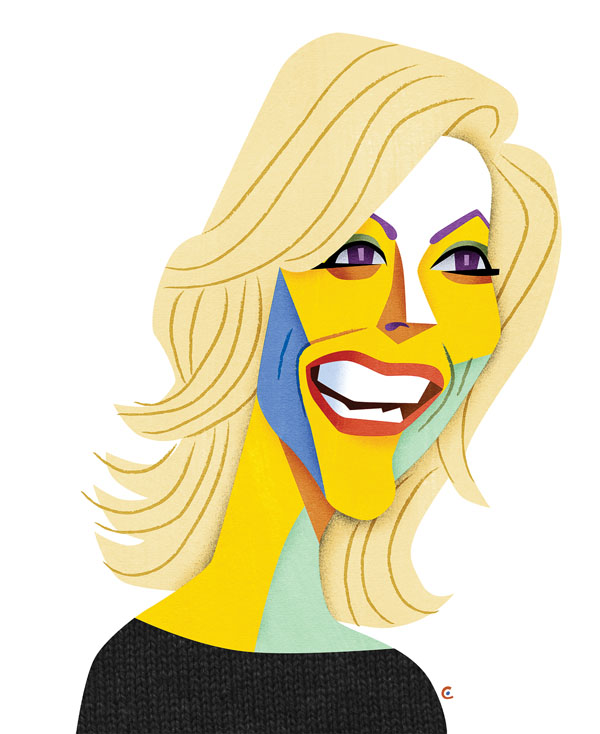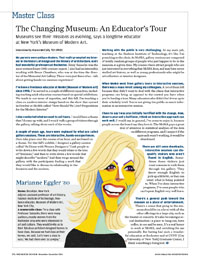Master Class
My parents were antique dealers. That really prompted my interest in the history of design and the history of architecture. And I had wonderful professors at Rochester. Rémy Saisselin was the most extraordinary 18th-century expert. I also had an internship working with Bruce Chambers, who was at the time the director of the Memorial Art Gallery. There were just three of us—talk about getting hands-on museum experience!
I’ve been a freelance educator at MoMA [Museum of Modern Art] since 1998. I’ve served in a couple of different capacities, including teaching adult education courses based on special exhibitions. We teach in our areas of expertise, and this fall, I’m teaching a class on modern interior design based on the show that opened in October at MoMA called “How Should We Live? Propositions for the Modern Interior.”
I also conducted what we used to call tours. I would have a theme that I’d come up with, and I would walk a group of visitors through the gallery, talking about each of the works.
 (Illustration: David Cowles for Rochester Review)
(Illustration: David Cowles for Rochester Review)A couple of years ago, tours were replaced by what are called gallery sessions. These are interactive, hands-on experiences. Ours take place over the course of an hour, and are based on a theme. For this fall’s exhibit, I designed a gallery session called “At Home with Women Designers.” I ask people to write down a few words that they would relate to the idea of “feminine,” and then to write down a few words that might describe “modern.” And then we go around the gallery, with the participants finding a work that they would like to discuss in relationship to the feminine and the modern.
Working with the public is very challenging. At my main job, teaching at the Fashion Institute of Technology, it’s like I’m preaching to the choir. At MoMA, gallery sessions are composed of totally random groups of people who just happen to be in the museum at a given time. My courses there attract people who are just interested in everything that MoMA does, and may have never studied art history, as well as young professionals who might be art collectors or interior designers.
When MoMA went from gallery tours to interactive sessions, there was a mass revolt among my colleagues. A lot of them left because they didn’t want to deal with the chaos that interactive programs can bring, as opposed to the control you have when you’re leading a tour. Many educators also didn’t feel it was up to their scholarly level. You’re not giving the public as much information in an interactive session.
I have to say I was also initially horrified with the change. Now, about a year and a half later, I think an interactive approach can work well. I would say, in general, I’ve come to enjoy it, because people across the board say they love it. The MoMA pays a great deal of attention to statistical analyses of the data on different programs, and I suspect if the approach wasn’t working, it would be abandoned.
There are still some drawbacks. Interactive sessions can disqualify visitors who aren’t fluent in English. Sometimes these visitors just want someone to walk them through the gallery. They know enough English to pick up a little bit, or they can intuit what is being pointed to. When I’ve done interactive programs, I’ve seen people who can’t speak English very well leave.
There’s a general push toward the museum as a place of entertainment. There’s a sense that going to the museum should be on a level with all the other offerings in a large city, such as the theater or concerts. It’s also becoming a social destination—a place to hang out, have coffee, to see and be seen. It’s a real honor to work at MoMA, and enriching for me personally. But having had such a wonderful education at Rochester and at CUNY [City University of New York] Graduate Center, I think something’s being lost.
Marianne Eggler ’80
Home: Brooklyn, New York
Adjunct assistant professor of art history, Fashion Institute of Technology; freelance educator, Museum of Modern Art, New York City.
A memorable class: “In a class with Professor Saisselin, there were many auditors, mostly women from the Rochester area who were interested in art and culture. They would invite us to their fabulous architect-designed homes to have class. Because we had class at their homes, we said, ‘Let’s have a class in ours.’ We had them over to Lovejoy.”

